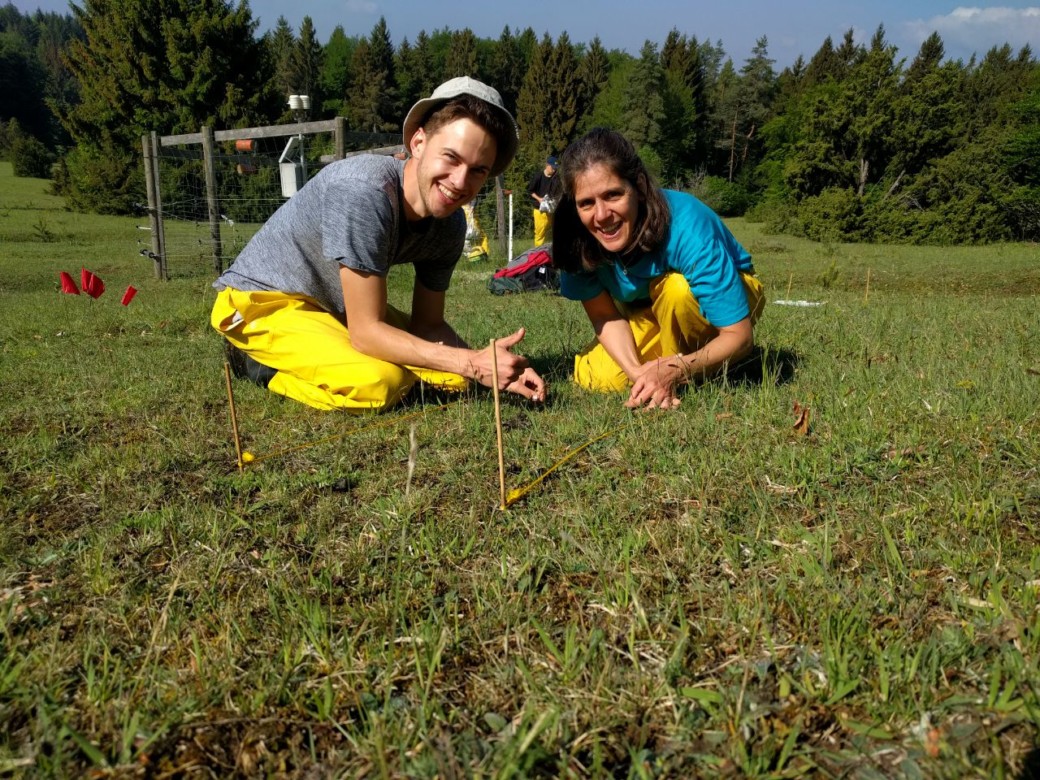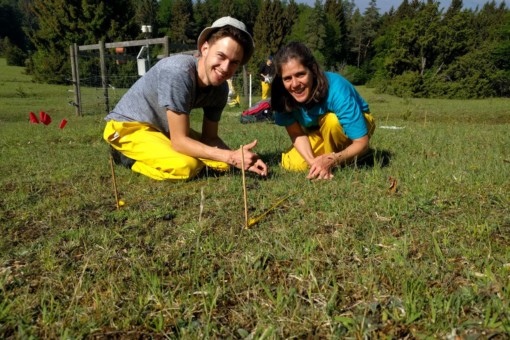Pflanzendiversität und pflanzenbezogene Prozesse
Auch in dieser Projektphase wird das Kernprojekt Botanik die Diversität höherer Gefäßpflanzen, Flechten, Moose und Pilze, die Produktivität von Grünländern und, in Experimenten, der Einfluss von Ausbreitungslimitierung und Störung untersuchen.

Seit Beginn der Biodiversitäts-Exploratorien wurde im Rahmen des Kernprojekts Botanik die Vielfalt von Gefäßpflanzen, Flechten und Moosen sowohl im Grünland als auch in Wäldern untersucht, und als wichtiger Ökosystemprozess die Produktivität von Grünland. Als Primärproduzenten sind Pflanzen von grundlegender Bedeutung für das Verständnis der Auswirkungen der Landnutzung auf Ökosystemprozesse, da viele Landnutzungseffekte über Veränderungen der Pflanzenvielfalt vermittelt werden, die sich kaskadenartig auf das gesamte Nahrungsnetz auswirken.
Die Hauptziele des vorliegenden Projekts sind:
- Bereitstellung langfristiger Daten über die Pflanzenvielfalt in Grünland und Wald, um die Auswirkungen der Landnutzung auf die Pflanzenvielfalt zu verstehen,
- Schätzung der intraspezifischen Variation ausgewählter funktioneller Merkmale von Pflanzen, um eine zusätzliche Ebene der Vielfalt zu schaffen,
- Bereitstellung der oberirdischen Produktivität von Grünland und der Unterbodenvegetation in Wäldern als einem wichtigen Ökosystemprozess von Pflanzen,
- Unterstützung der Grünlandexperimente REX und LUX, bei denen die Intensität der Landnutzung und die Verfügbarkeit von Pflanzgut manipuliert werden, sowie des Waldexperiments FOX, bei dem Waldlücken zur Untersuchung der Unterholzvegetation und der Waldverjüngung geschaffen wurden.
Darüber hinaus ermöglichen uns die langfristigen Datenreihen zur Pflanzendiversität und zu Ökosystemprozessen, die Stabilität der Gemeinschaft, die Regenerationsfähigkeit von Gemeinschaften nach Störungen und die zeitlichen Trends in der Zusammensetzung der Gemeinschaft und der Häufigkeit einzelner Arten abzuschätzen. Zusammen mit der Überwachung liefern diese Daten wichtige Basisinformationen für andere Projekte, da viele Taxa und Ökosystemprozesse direkt oder indirekt durch pflanzenbezogene Veränderungen beeinflusst werden.
Alle Kernprojekte liefern wichtige Basisinformationen zu Landnutzung, Diversität und Ökosystemprozessen (Langzeitmonitoring). Diese werden allen Teil- und Kernprojekten für die Erforschung tiefergehender Fragestellungen zur Verfügung gestellt.
Services der aktuellen Phase
In der 6. Phase (2020-2023) liefert das Kernprojekt Botanik grundlegende Informationen über:
- Waldvegetationsmonitoring im Frühjahr und Sommer auf 20 x 20 m auf allen EPs und im FOX-Experiment
- Überwachung der Grünlandvegetation im Frühjahr auf 4 x 4 m auf allen EPs und im REX/LUX-Experiment
- Vegetationshöhe auf allen Grünland-EPs und im REX/LUX-Experiment
- Biomasseproduktion im Grünland auf 1 x 1 m auf allen EPs und im REX/LUX-Experiment
- Biomasseproduktion im Waldunterholz auf allen Wald-EPs
Services in den früheren Phasen
In früheren Phasen lieferte das Kernprojekt Botanik auch grundlegende Informationen über:
- Bryophytenvielfalt auf allen Rasterparzellen in 2008/9
- Flechtenvielfalt auf allen Rasterparzellen in 2008/9
- Pilzerreger-Diversität auf allen Grünland-EP im Jahr 2012
- Totholzpilz-Diversität auf allen Wald-EP im Jahr 2012
- Schätzung der Ausbreitungsbeschränkung auf allen Grünland-MIPS in den Jahren 2012 und 2019
- Messung der phänotypischen Plastizität ausgewählter Grünlandarten in einem “common garden” im Jahr 2012
- Analyse der Bodensamenbank auf allen Grünland-MIPS im Jahr 2015
- Schätzung der intraspezifischen Merkmalsvariation der zehn häufigsten Arten in allen EPs in den Jahren 2017/18
Im Grünland führte die Landnutzungsintensität zu einer Verringerung der Grünlandvielfalt und einer Erhöhung der Produktivität. Während die Diversität hauptsächlich von der Mähintensität beeinflusst wurde, wurde die Produktivität von der Düngung und den Bodenbedingungen beeinflusst. Darüber hinaus fanden wir bei vielen Grünlandarten Anzeichen für eine eingeschränkte Ausbreitung, was darauf hindeutet, dass viele Grünlandflächen nicht gesättigt sind und ihre Vielfalt erhöht werden könnte. Darüber hinaus führte die negative Auswirkung der Landnutzung auf die Pflanzenvielfalt zu einer stabileren Zusammensetzung der Graslandgemeinschaften bei hoher Landnutzung, während die Gemeinschaften bei niedriger Landnutzung im Laufe der Zeit stärker variierten.
In den Wäldern wirkte sich die Bewirtschaftung positiv auf die Pflanzenvielfalt aus, was vor allem auf bewirtschaftungsbedingte Störungen, z. B. Holzabfuhrwege, zurückzuführen ist. Zu den durch die Waldbewirtschaftung geförderten Arten gehörten vor allem lichtbedürftige Arten im Unterholz, während typische Waldarten eher negativ auf die Waldbewirtschaftung reagierten. Während sich die Pflanzenvielfalt in den letzten 15 Jahren insgesamt nicht verändert hat, wurde sie auf einzelnen Parzellen entweder durch Windwurf oder durch Holzeinschlag stark beeinträchtigt.










